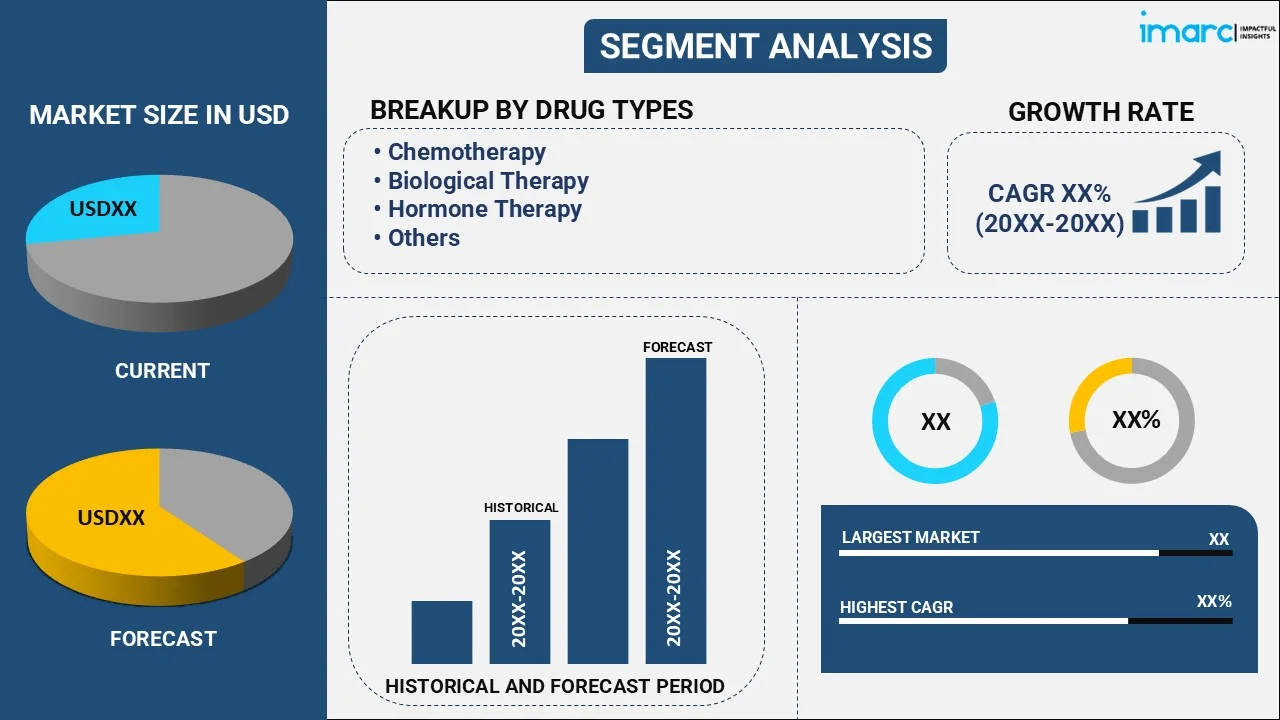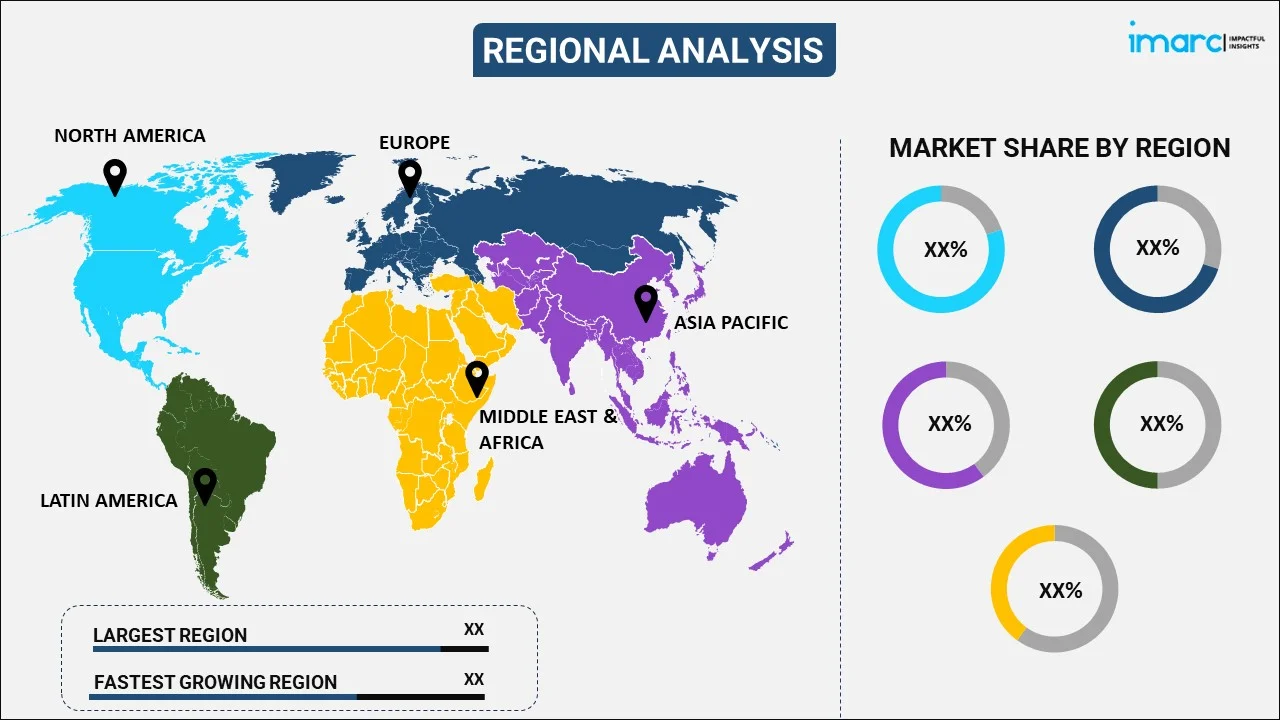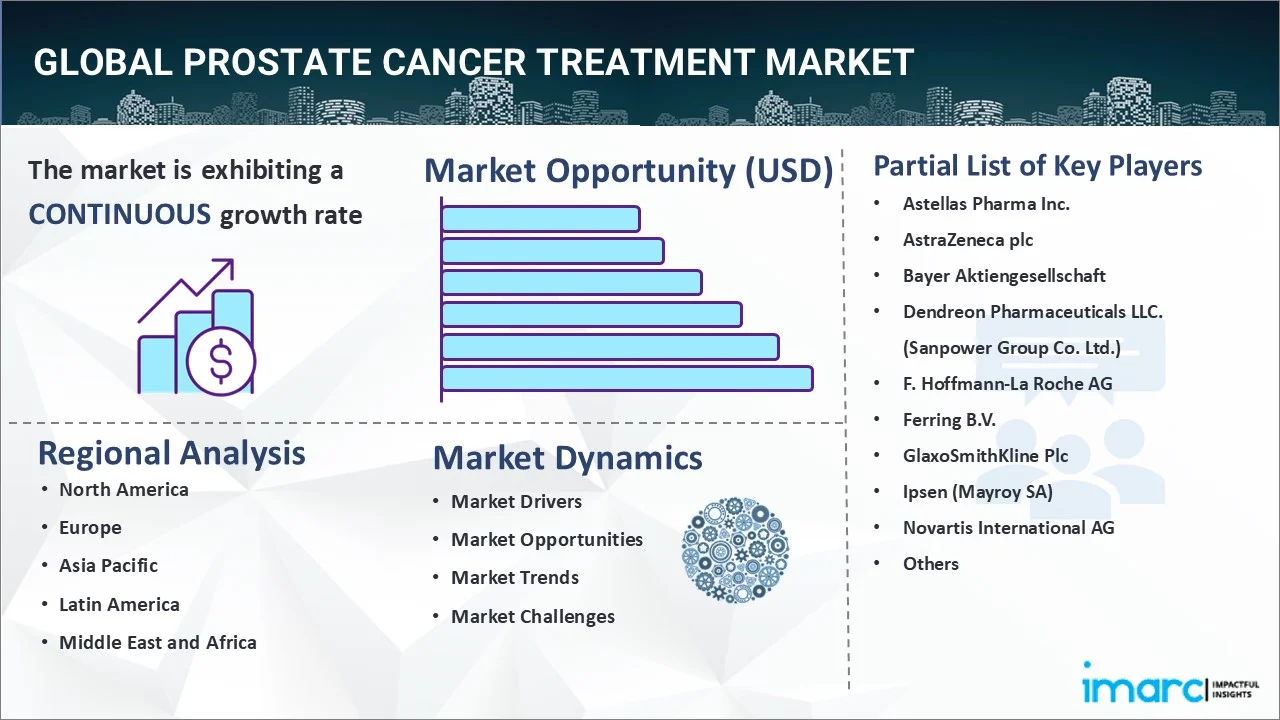
Prostate Cancer Treatment Market Report by Drug Type (Chemotherapy, Biological Therapy, Hormone Therapy, and Others), Distribution Channel (Hospitals Pharmacies, Drug Stores and Retail Pharmacies, Online Pharmacies), and Region 2025-2033
Prostate Cancer Treatment Market Size:
The global prostate cancer treatment market size reached USD 8.1 Billion in 2024. Looking forward, IMARC Group expects the market to reach USD 12.4 Billion by 2033, exhibiting a growth rate (CAGR) of 4.9% during 2025-2033. The increasing prevalence of the disease, advancements in personalized medicine, the emergence of new therapies, higher healthcare spending, and growing public awareness about prostate health and available treatment options are strengthening the market growth.
|
Report Attribute
|
Key Statistics
|
|---|---|
|
Base Year
|
2024
|
|
Forecast Years
|
2025-2033
|
|
Historical Years
|
2019-2024
|
|
Market Size in 2024
|
USD 8.1 Billion |
|
Market Forecast in 2033
|
USD 12.4 Billion |
| Market Growth Rate 2025-2033 | 4.9% |
Prostate Cancer Treatment Market Analysis:
- Major Market Drivers: The rising incidence of prostate cancer across the globe is significantly driving the market, as increasing numbers of cases necessitate more robust treatment solutions. In addition to this, ongoing advancements in personalized medicine and genomics are enabling more precise and effective treatments, thereby propelling the market growth.
- Key Market Trends: The use of combination therapies in treating prostate cancer, which involves using multiple treatment modalities simultaneously to enhance efficacy and patient outcomes, is one of the major prostate cancer treatment market trends. In confluence with this, targeted and personalized therapies are becoming more valuable. These therapies utilize the patient's tumor's genetic profile to customize treatment, propelling the market growth.
- Geographical Trends: The prostate cancer treatment market forecast indicates North America as the leading region due to its advanced healthcare infrastructure, high healthcare expenditure, and proactive cancer screening programs. Besides this, Asia-Pacific is experiencing rapid growth in the market, driven by increasing healthcare awareness, rising healthcare spending, and improvements in healthcare infrastructure.
- Competitive Landscape: Some of the major market players in the prostate cancer treatment industry include Astellas Pharma Inc., AstraZeneca plc, Bayer Aktiengesellschaft, and Dendreon Pharmaceuticals LLC. (Sanpower Group Co. Ltd.), F. Hoffmann-La Roche AG, Ferring B.V., GlaxoSmithKline Plc, Ipsen (Mayroy SA), Novartis International AG, Takeda Pharmaceutical Company Ltd., and Tolmar Pharmaceuticals Inc., among many others.
- Challenges and Opportunities: The high cost of advanced treatments is one of the primary obstacles, which can make them inaccessible to patients in less developed areas. However, the prostate cancer treatment market has recent opportunities for healthcare providers and insurers to innovate in cost management and patient financing models. Besides this, the market also faces regulatory challenges that can delay drug approvals and market entry. Nonetheless, ongoing research and collaboration among pharmaceutical companies and academic institutions present lucrative prospects for breakthroughs in treatment options and strategies.
Prostate Cancer Treatment Market Trends:
Advancements in Personalized Medicine and Genomics:
Prostate cancer treatment market overview shows that personalized medicine, which involves tailoring medical treatment to the individual characteristics of each patient, based on genetic information is aiding in market expansion. In prostate cancer treatment, genomic profiling helps in identifying specific mutations and gene expressions that may influence the behavior of cancer. Moreover, with more than 375,304 registered cases of prostate cancer across the globe, there is a growing demand for personalized medicines, which enables healthcare providers to choose therapies that are most likely to work based on the patient’s genetic profile. Such tailored treatments increase efficacy and minimize unwanted side effects, thus supporting the prostate cancer treatment market growth.
Emergence of Advanced Therapeutic Options:
The treatment landscape for prostate cancer has evolved with the introduction of advanced therapeutic options such as new-generation hormone therapies, immunotherapies, and targeted therapies. Hormone therapies, such as new androgen axis drugs, have shown significant effectiveness in managing prostate cancer by inhibiting the growth of cancer cells that use androgens to grow and survive. Immunotherapies that help the immune system recognize and combat cancer cells are also gaining value. For instance, according to the research, one in twenty men with end-stage prostate cancer responded to the immunotherapy pembrolizumab. Furthermore, the emergence of targeted therapies, which concentrate on particular pathways or mechanisms involved in the development of cancer, thereby providing a more focused treatment approach with potentially fewer side effects compared to conventional chemotherapy is boosting the prostate cancer treatment demand.
Increasing Focus on Combination Therapies:
There is a growing trend towards the use of combination therapies to enhance treatment efficacy, particularly in advanced stages of prostate cancer. Combining different types of treatments, such as radiation therapy with hormone therapy or chemotherapy with new biologics, has been found to improve outcomes by attacking cancer cells in multiple ways. This method is especially helpful when prostate cancer refuses to respond to conventional therapies. Clinical trials are continuously exploring various combinations to determine the most effective protocols. In a study, 5% of patients achieved a complete response, 47% had a confirmed partial response, 28% maintained stable disease, and 21% experienced progressive disease, highlighting the potential of these therapies in prostate cancer treatment. Consequently, the increasing investments in combination therapies to increase the overall survival rate and quality of life for patients is positively impacting the prostate cancer treatment market outlook.
Prostate Cancer Treatment Market Segmentation:
IMARC Group provides an analysis of the key trends in each segment of the market, along with forecasts at the global, regional, and country levels for 2025-2033. Our report has categorized the market based on drug type, and distribution channel.
Breakup by Drug Type:

- Chemotherapy
- Biological Therapy
- Hormone Therapy
- Others
Hormone therapy accounts for the majority of the market share
The report has provided a detailed breakup and analysis of the market based on the drug type. This includes chemotherapy, biological therapy, hormone therapy, and others. According to the report, hormone therapy represented the largest segment.
Hormone therapy, also known as androgen deprivation therapy (ADT), holds a significant prostate cancer treatment market share due to its effectiveness in managing prostate cancer, particularly in its advanced stages. Prostate cancer growth is fueled by androgens, including testosterone. By limiting the synthesis of these androgens or inhibiting their impact on prostate cancer cells, hormone therapy slows or stops the disease's progression. This method is pivotal for patients whose cancer has metastasized beyond the prostate gland and for those who are not candidates for surgery or radiation. Additionally, hormone therapy is frequently used in combination with other treatments, such as radiation therapy, to improve outcomes, particularly in high-risk localized cancers, which is further bolstering the prostate cancer treatment industry.
Breakup by Distribution Channel:
- Hospitals Pharmacies
- Drug Stores and Retail Pharmacies
- Online Pharmacies
Hospitals pharmacies hold the largest share of the industry
A detailed breakup and analysis of the market based on the distribution channel have also been provided in the report. This includes hospitals, drug stores and retail, and online pharmacies. According to the report, hospitals pharmacies accounted for the largest market share.
Hospital pharmacies are the leading segment propelling the prostate cancer treatment market revenue due to the complex nature of cancer treatment which often requires specialized medications that are administered under strict medical supervision. Hospital settings provide the integrated healthcare services necessary for the multifaceted approach needed in cancer treatment, including surgery, chemotherapy, radiation, and hormone therapy. These treatments, particularly chemotherapeutic agents and advanced immunotherapies, often require precise handling, storage conditions, and administration protocols that are best managed within hospital pharmacies. Additionally, the immediate availability of pharmaceuticals in hospital pharmacies ensures timely treatment, which is crucial for cancer care. Furthermore, the centralized care model of hospitals, coupled with the need for specialized care protocols for prostate cancer, reinforces the dominant role of hospital pharmacies in the industry, fostering market expansion.
Breakup by Region:

- North America
- United States
- Canada
- Asia-Pacific
- China
- Japan
- India
- South Korea
- Australia
- Indonesia
- Others
- Europe
- Germany
- France
- United Kingdom
- Italy
- Spain
- Russia
- Others
- Latin America
- Brazil
- Mexico
- Others
- Middle East and Africa
North America leads the market, accounting for the largest prostate cancer treatment market share
The report has also provided a comprehensive analysis of all the major regional markets, which include North America (the United States and Canada); Asia Pacific (China, Japan, India, South Korea, Australia, Indonesia, and others); Europe (Germany, France, the United Kingdom, Italy, Spain, Russia, and others); Latin America (Brazil, Mexico, and others); and the Middle East and Africa. According to the report, North America represents the largest regional market for prostate cancer treatment.
Prostate cancer treatment market analysis revealed North America as the leading region due to its advanced healthcare infrastructure, high healthcare spending, and strong presence of leading pharmaceutical and biotechnology companies engaged in cancer research and drug development. The region benefits from a robust regulatory framework supportive of rapid advancements in medical technologies and therapeutic approaches, including new drug approvals and innovative treatment modalities. Additionally, there is a high awareness of prostate cancer risks and symptoms among the population, coupled with widespread screening practices that lead to early detection and treatment. This early detection significantly contributes to better treatment outcomes and sustained investments in prostate health. Moreover, the presence of some of the world's leading cancer research institutions in North America, such as the National Cancer Institute and top-tier universities, drives continuous innovation and improvement in prostate cancer therapies, further solidifying the region's leading position in the global market.
Competitive Landscape:
- The market research report has also provided a comprehensive analysis of the competitive landscape in the market. Detailed profiles of all major companies have also been provided. Some of the major market players in the prostate cancer treatment industry include Astellas Pharma Inc., AstraZeneca plc, Bayer Aktiengesellschaft, Dendreon Pharmaceuticals LLC. (Sanpower Group Co. Ltd.), F. Hoffmann-La Roche AG, Ferring B.V., GlaxoSmithKline Plc, Ipsen (Mayroy SA), Novartis International AG, Takeda Pharmaceutical Company Ltd., Tolmar Pharmaceuticals Inc., etc.
(Please note that this is only a partial list of the key players, and the complete list is provided in the report.)
- The market is highly competitive, featuring a mix of established pharmaceutical giants and specialized biotech firms. Astellas Pharma Inc. and AstraZeneca plc are prominent prostate cancer treatment companies known for their innovative therapies and significant R&D investments in oncology. They have expanded their portfolio with targeted treatments and are focusing on immunotherapies for advanced prostate cancer. These companies are also offering effective chemotherapeutic and hormonal treatments. They are also focusing on the development of therapies with improved efficacy and reduced side effects. The key players leverage their vast global networks to distribute and develop next-generation treatments.
Prostate Cancer Treatment Market News:
- In October 2020, Bayer acquired Asklepios BioPharmaceutical (AskBio) in a strategic move to enhance its cell and gene therapy capabilities. The deal, valued at up to $4 billion, includes an upfront payment of $2 billion and potential milestone payments of up to $2 billion. This acquisition aims to bolster Bayer's innovation pipeline and solidify its position in the rapidly growing gene therapy market.
Prostate Cancer Treatment Market Report Scope:
| Report Features | Details |
|---|---|
| Base Year of the Analysis | 2024 |
| Historical Period | 2019-2024 |
| Forecast Period | 2025-2033 |
| Units | Billion USD |
| Scope of the Report | Exploration of Historical Trends and Market Outlook, Industry Catalysts and Challenges, Segment-Wise Historical and Future Market Assessment:
|
| Drug Types Covered | Chemotherapy, Biological Therapy, Hormone Therapy, Others |
| Distribution Channels Covered | Hospitals Pharmacies, Drug Stores and Retail Pharmacies, Online Pharmacies |
| Regions Covered | Asia Pacific, Europe, North America, Latin America, Middle East and Africa |
| Countries Covered | United States, Canada, Germany, France, United Kingdom, Italy, Spain, Russia, China, Japan, India, South Korea, Australia, Indonesia, Brazil, Mexico |
| Companies Covered | Astellas Pharma Inc., AstraZeneca plc, Bayer Aktiengesellschaft, Dendreon Pharmaceuticals LLC. (Sanpower Group Co. Ltd.), F. Hoffmann-La Roche AG, Ferring B.V., GlaxoSmithKline Plc, Ipsen (Mayroy SA), Novartis International AG, Takeda Pharmaceutical Company Ltd., Tolmar Pharmaceuticals Inc., etc. |
| Customization Scope | 10% Free Customization |
| Post-Sale Analyst Support | 10-12 Weeks |
| Delivery Format | PDF and Excel through Email (We can also provide the editable version of the report in PPT/Word format on special request) |
Key Benefits for Stakeholders:
- IMARC’s industry report offers a comprehensive quantitative analysis of various market segments, historical and current market trends, market forecasts, and dynamics of the prostate cancer treatment market from 2019-2033.
- The research report provides the latest information on the market drivers, challenges, and opportunities in the global prostate cancer treatment market.
- The study maps the leading, as well as the fastest-growing, regional markets. It further enables stakeholders to identify the key country-level markets within each region.
- Porter's five forces analysis assists stakeholders in assessing the impact of new entrants, competitive rivalry, supplier power, buyer power, and the threat of substitution. It helps stakeholders to analyze the level of competition within the prostate cancer treatment industry and its attractiveness.
- The competitive landscape allows stakeholders to understand their competitive environment and provides insight into the current positions of key players in the market.
Key Questions Answered in This Report
The global prostate cancer treatment market was valued at USD 8.1 Billion in 2024.
We expect the global prostate cancer treatment market to exhibit a CAGR of 4.9% during 2025-2033.
The rising integration of multiparametric-Magnetic Resonance Imaging (mp-MRI) devices with non-metastatic Castration-Resistant (nmCRPC) and metastatic Hormone Nave (mHNPC) settings to detect prostate cancer at early stages and mitigate diagnostic errors is primarily driving the global prostate cancer treatment market.
The sudden outbreak of the COVID-19 pandemic had led to the postponement of elective prostate cancer treatments to reduce the risk of the coronavirus infection upon hospital visits or interaction with healthcare professionals and medical equipment.
Based on the drug type, the global prostate cancer treatment market has been segregated into chemotherapy, biological therapy, hormone therapy, and others. Among these, hormone therapy currently exhibits clear dominance in the market.
Based on the distribution channel, the global prostate cancer treatment market can be bifurcated into hospitals pharmacies, drug stores and retail pharmacies, and online pharmacies. Currently, hospitals pharmacies hold the largest market share.
On a regional level, the market has been classified into North America, Asia-Pacific, Europe, Latin America, and Middle East and Africa, where North America currently dominates the global market.
Some of the major players in the global prostate cancer treatment market include Astellas Pharma Inc., AstraZeneca plc, Bayer Aktiengesellschaft, Dendreon Pharmaceuticals LLC. (Sanpower Group Co. Ltd.), F. Hoffmann-La Roche AG, Ferring B.V., GlaxoSmithKline Plc, Ipsen (Mayroy SA), Novartis International AG, Takeda Pharmaceutical Company Ltd., and Tolmar Pharmaceuticals Inc.
Need more help?
- Speak to our experienced analysts for insights on the current market scenarios.
- Include additional segments and countries to customize the report as per your requirement.
- Gain an unparalleled competitive advantage in your domain by understanding how to utilize the report and positively impacting your operations and revenue.
- For further assistance, please connect with our analysts.

 Inquire Before Buying
Inquire Before Buying
 Speak to an Analyst
Speak to an Analyst
 Request Brochure
Request Brochure
 Request Customization
Request Customization




.webp)




.webp)












